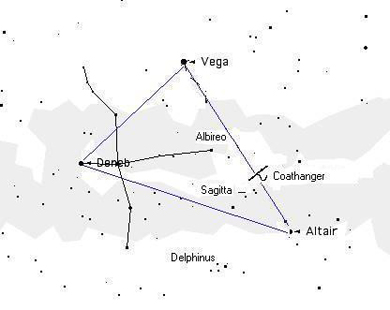Editor’s note:
Amateur astronomer Larry Pawlitsky has agreed to provide local star-gazers with some tips on what they can see in the evening sky using binoculars, small home telescopes or even just the naked eye. This first column focuses on the Summer Triangle.

In addition to the 88 “official” constellations, there are also “asterisms” to be found among the stars. These are not constellations; they are simply noticeable star patterns. One of the most famous and prominent asterisms in the northern hemisphere sky is the Summer Triangle.
As darkness falls on summer evenings, three stars pop into view high in the eastern sky. If you join these stars with an imaginary line, a huge triangle will be revealed. Known as the Summer Triangle, this large asterism is composed of three bright stars, each the brightest star in its own constellation. These stars are Vega in the constellation Lyra, Deneb in the constellation Cygnus, and Altair in the constellation Aquila. Their bright and sparkling radiance is even visible from light-polluted cities.
The Summer Triangle is big! So don’t look for a tiny pattern. The three stars of the Triangle really stand out before it gets too dark and before the countless stars of the Milky Way slowly dance into view making the Triangle harder to pick out. For the best observing, pick a dark site away from lights and allow your eyes at least 10 minutes to adjust to the dark.

Brightest of the Triangle’s stars is Vega, found high overhead during the summer months. Vega is a brilliant blue-white star that glistens like a diamond within the lovely constellation Lyra the Lyre or Harp . If you look at Vega through binoculars, you will see a tiny but bright double star system to the left of Vega in the same binocular view. Notice how Vega is part of its own small triangle of stars.
Below and to the left of Vega is the second star of the triangle, Deneb …the brightest star in the constellation Cygnus the Swan. Deneb represents its tail, and the “eye” of the swan, the dim star Albireo, is found roughly halfway between Vega and Altair. Cygnus is also known as the Northern Cross because of its distinctive shape. In this case, Deneb is the top of the Cross and Albireo, the bottom. As for its crosspiece, look for three equally spaced stars that cross the “T” near Deneb. The Northern Cross lies completely within the Summer Triangle and appears horizontal early in the night.
Altair – the third star below the others – is at the bottom of the imaginary triangle, anchoring the constellation Aquila, the Eagle. Altair shines brightly in the middle of two dimmer stars. It’s pretty close star wise, only 16 light years away and it’s one of the strangest stars around. About 1 1/2 times our Sun’s size and 9 times brighter; Altair’s rotational speed is what makes it so peculiar. Our Sun rotates once every 25 1/2 days… but Altair rotates once every 6 1/2 hours!
A rich region of the Milky Way runs right through the midst of the Summer Triangle and extends on either side. It appears hazy or milky to the eye … hence the name. If you point your binoculars into the middle of the Summer Triangle, you will be amazed at the thousands of sparkling little stars! That’s because you’re looking edgewise right into our own galaxy!
Still using your binocs, look for the marvelous little Coathanger Star Cluster. It’s about a third of the way up on a line from Altair to Vega. It really looks like a Coathanger… hanging upside down with its hook open to the right! Just below the Coathanger and to the left are four bright stars in the shape of an arrow… that’s the sky’s smallest constellation, Sagitta, the Arrow. And below the line between Deneb and Altair but closer to Altair is the diamond shaped constellation of Delphinus, the Dolphin. All these sights will each fit into a binocular view.
Once you learn to recognize the Summer Triangle, it will become a familiar sight year after year as it wheels high across the summer sky. And you’ll always know where to look for the Milky Way! As our Earth turns throughout the night, Vega, Deneb and Altair travel westward across the sky. The Summer Triangle shines high overhead in the middle of the night, and sparkles in the west as the rose-colored dawn begins to color the sky.
The large brilliant star-like object rising in the southeast before midnight and shining brightly in the southwest by dawn is the king of planets — Jupiter.
Clear Skies!
Larry Pawlitsky is a local amateur astronomer



